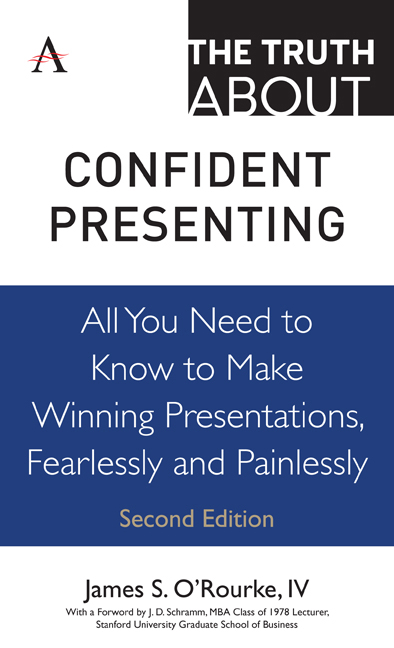 The Truth about Confident Presenting
The Truth about Confident Presenting Book contents
- Frontmatter
- Contents
- Foreword
- Introduction
- Part I Some Initial Truths
- Part II The Truth About Getting Ready to Speak
- Part III The Truth About What Makes People Listen
- Part IV The Truth About Developing Support for Your Presentation
- Part V The Truth About Getting Up to Speak
- Part VI The Truth About Managing Anxiety
- Part VII The Truth About Nonverbal Communication
- Part VIII The Truth About Visual Aids
- Part IX The Truth About Handling an Audience
- Part X The Truth About What Makes a Presentation Work
- References
- Acknowledgments
- About the Author
Introduction
- Frontmatter
- Contents
- Foreword
- Introduction
- Part I Some Initial Truths
- Part II The Truth About Getting Ready to Speak
- Part III The Truth About What Makes People Listen
- Part IV The Truth About Developing Support for Your Presentation
- Part V The Truth About Getting Up to Speak
- Part VI The Truth About Managing Anxiety
- Part VII The Truth About Nonverbal Communication
- Part VIII The Truth About Visual Aids
- Part IX The Truth About Handling an Audience
- Part X The Truth About What Makes a Presentation Work
- References
- Acknowledgments
- About the Author
Summary
Harvard Business School Professor John Kotter studied a number of successful general managers over a fiveyear period and found that they spend most of their time with other people, including subordinates, their bosses and numerous others from outside the organization. His study found that the average manager spent just 25 percent of his or her time working alone. Most of that time with others, Kotter found, was spent talking and listening— and a sizable fraction was spent presenting ideas and actions to others.
Similarly, management consultant Dierdre Borden found that successful managers spend about 75 percent of their time in verbal interaction with others: on the telephone, face-to-face, in meetings and in presentations to groups large and small. The fact is, most information in contemporary business and social settings is passed orally, and the most important of our ideas are frequently formalized in presentations to clients, customers, shareholders, superiors and key decision makers.
You can't avoid it. At some point soon in your career, you're going to be asked to give a presentation. The problem is that most people are genuinely apprehensive about doing that. We can compose a memo, letter, report or e-mail in the quiet and comfort of our home or office, but standing up in front of a group to offer our thoughts— or to motivate them to action— is simply frightening to many people.
Like it or not, during a presentation you're being evaluated by everyone in the audience. You're being sized up, critiqued and assessed. For those 15 or 20 minutes, your value to the organization, your career, your future are on the line. No wonder people get nervous.
I've been teaching public speaking to business school students, government and military officials, and professionals in all lines of work for nearly 50 years and I've learned one simple truth about public speaking: it's not easy, but it's certainly doable. I've helped people overcome fears, anxieties and apprehensions of all sorts and watched them go on to wow an audience with their presentation skills. If they can do it, so can you.
This book, simple and compact as it is, can do three things for you. First, it can help you to diagnose your own current speaking abilities. It'll help you size up your skill levels and get some sense of whether you're “ready for prime time.”
- Type
- Chapter
- Information
- The Truth about Confident PresentingAll You Need To Know To Make Winning Presentations, Fearlessly And Painlessly, pp. xi - xiiPublisher: Anthem PressPrint publication year: 2019


